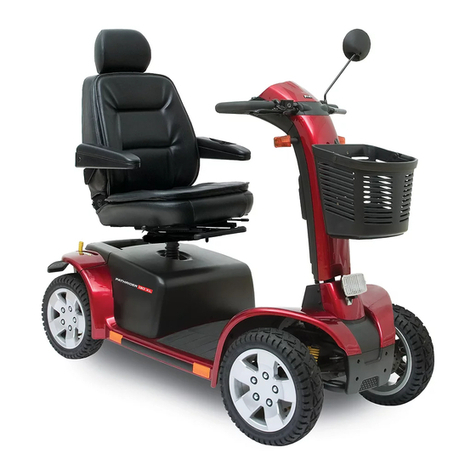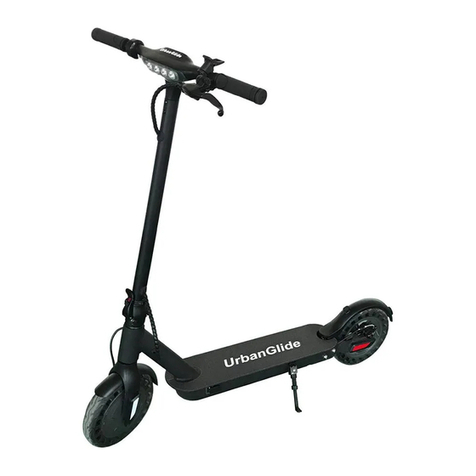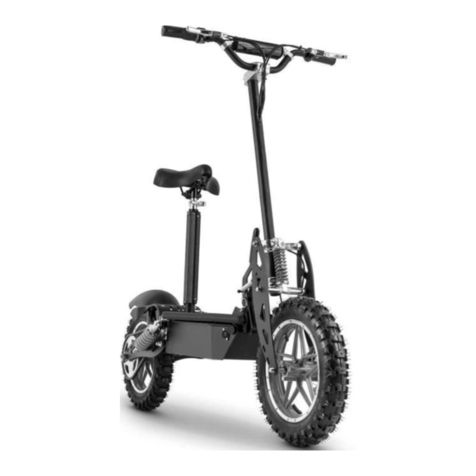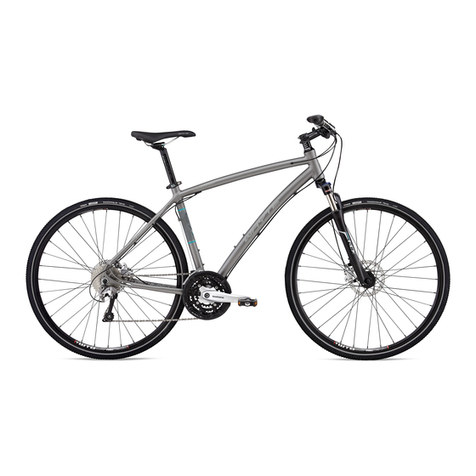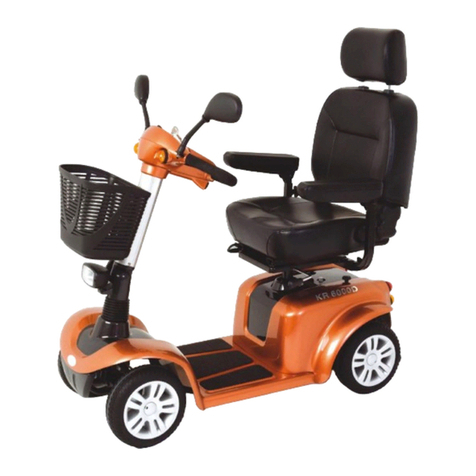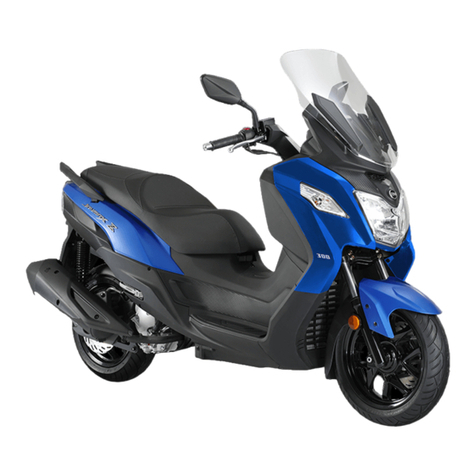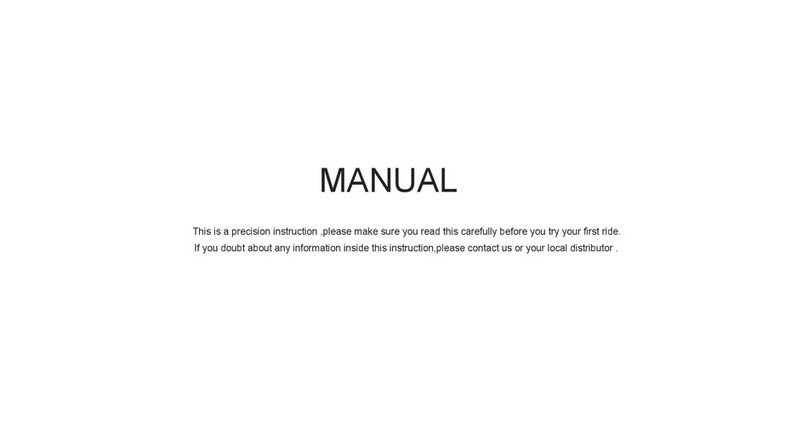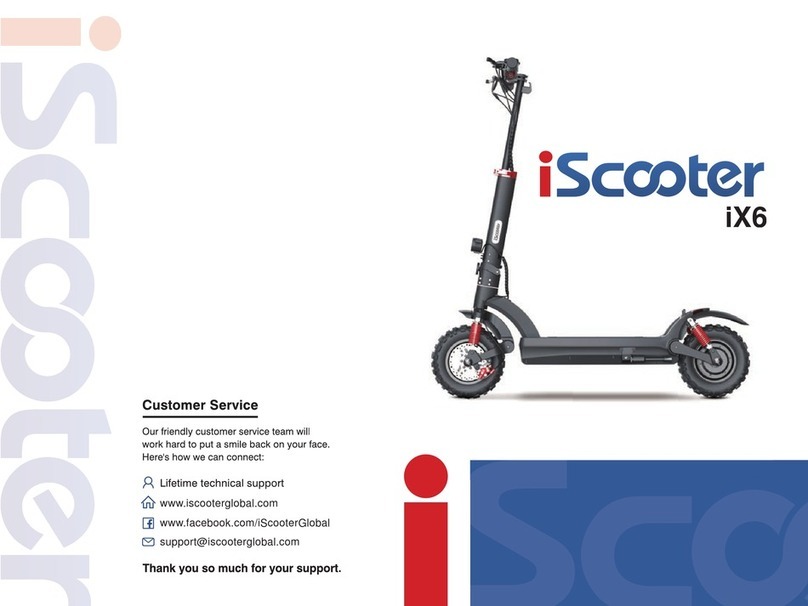BLUE FACTORY TEAM mondraker User manual

ENGLISH
OWNER’S MANUAL

OWNER’S MANUAL


4
Obviously bicycling involves risk of falling and injury. By choosing to ride a bicycle you assume the
responsibility for that risk, so you need to know and follow the rules of safe and responsible riding and
proper use and maintenance. Although riding a bike will never be entirely risk-free because there are
always external factors you cannot control, proper use will reduce that risk considerably.
This manual contains a number of “Warnings” and “Cautions”. If you do not follow them you will be using
your bike unsafely or it will not work as it should and that might expose you to danger.
Many of the Warnings and Cautions say things like “you may lose control and fall”. Because any fall can
result in serious injury or even death, we do not always repeat the warning of possible injury or death and
assume you are aware of it.
It is impossible to anticipate every situation or condition which might occur while riding, so this Manual
cannot warn you or advise you about how to handle all of them. Anyone who rides a bike must accept the
risk and be ready to cope with a wide variety of situations. Dealing with these situations or avoiding them
is the sole responsibility of the rider.
1. Importance and purpose of this manual
1.1 Why should you read this manual?
1.2 Bicycle parts
1.3 Bicycle types
1.4 Intended use of your bicycle
2. Adjusting your Mondraker bike
2.1 Riding position and bike assembly
2.2 Bike safety testing
2.3 Safety equipment
2.4 If you have a fall
3. Additional technical information
4. Maintenance
4.1 Cleaning
4.2 Lubricating
5. e-Bikes
6. Mondraker warranty
THANK YOU AND CONGRATULATIONS
GENERAL WARNING:
We appreciate your trust in Mondraker. This bicycle is the result of work done with the most advanced
technology and assembled with the best components for its use. The Mondraker bicycle range can cover
all your needs, from a great means of transport to a reliable competition bike or just for leisure.
WARNING: indicates a potentially hazardous situation which if not avoided could result in serious
injury or death.
CAUTION: indicates a situation with less serious consequences but which should also be avoided.
It is an alert against practices that are unsafe and which could result in damage to your bike or the
voiding of your warranty.
TABLE OF CONTENTS

5
1. IMPORTANCE AND PURPOSE OF THIS MANUAL
This manual will help you to adjust the bike to your body shape and size to increase riding comfort,
enjoyment and safety.
It is very important that you know about your bike’s parts and safety features and how to adjust the parts
in order to achieve maximum enjoyment and safety during your ride.
Note: the purpose of this manual is not to give you in-depth knowledge of the mechanics and operation
of your bike. Instead it is designed to show you how to carry out the essential checks before going for
a ride as well as basic maintenance. For your safety Mondraker recommends that if your bike does not
work properly you should take it to the Mondraker dealer where you bought it before trying to x the
problem yourself.
1.1 Why should you read this manual?
Riding a bike can be a high-risk activity for you if you do not do it with due caution and safety. So we
recommend you read this manual carefully.
1.2 Bicycle parts
Below are the names of all the different parts of your bicycle. This will help you to understand this manual
more easily.
1. Frame
2. Fork
3. Stem
4.Handlebar
9. Spoke
10. Hub
11. Pedal
12. Crankset
5. Brake lever
6. Shifters
7. Tires
8. Rim
13. Chain
14. Front derailleur
15. Rear derailleur
16. Sprockets
17. Brake
18. Seatpost
19. Saddle
20. Headset
EN

6
1.3 Bicycle types
Bicycles can be used in a great variety of ways so it is increasingly important to tailor the bike’s geometry
and parts to its intended use. It is important that you know the different bicycle types so you can use your
bicycle properly. Ride safely by knowing your bike’s limits. Your dealer will be able to advise you about
which bike is best based on what you are going to use it for.
1.3.1 Road bikes
They are also known as racing bikes as they were used in the rst road and triathlon competitions.
These bikes are used for fast rides, tough training and competition, especially on paved roads. They
are the lightest, most aerodynamic and fastest bikes. Their frames are made of very light and heavy-
duty materials to take full advantage of pedalling strength. Their geometry is designed so the rider
can adapt to the bicycle for more effective pedalling while keeping a more aerodynamic position. The
wheels of this type of bicycle have a wider diameter (28”) than standard mountain bikes and their tyres
are very narrow to reduce friction with the ground.
1.3.2 Mountain Bikes
These bicycles are designed for use on every kind of surface. They give the rider greater comfort and
safety on irregular surfaces such as forest trails or mountain paths. Their components are very resistant
to stone impacts and adverse weather conditions. The geometry of the frame ensures the rider is in a
more upright position with greater freedom of movement for better control over the bike on winding
terrain. There are two kinds of mountain bikes depending on whether the frame has a suspension
system or not.
1.3.2.1 Rigid frame bike
This type of bike is designed for riding on trails and mountain paths which are not very rough.
Sometimes these bikes are equipped with light front suspension and disc brakes. These are
normally 20- or 30-speed bikes to adapt pedalling rhythm to the track you are riding on.
Note: These bikes are not designed for fast downhill riding or jumping. You are putting your safety
at risk.
1.3.2.2 Full suspension bike
The evolution of mountain bikes has led to the manufacture of full suspension bikes. They enable
riders to travel over rough terrain in greater comfort and also make descents easier by absorbing
bumps and potholes. Full suspension frames have been developed for more aggressive riding or
steeper descents. They normally have thicker tyres than rigid frame bikes for greater safety and
stability. They are made with tougher components and have longer front suspension travel. The
important thing is not weight but the reliability and strength of the materials that are exposed to
greater wear and fatigue. As a general rule, the geometry of this kind of bikes is designed to provide
more comfort and riding control rather than an effective position for pedalling.
1.3.3 Urban bikes
These bikes are used as a means of transport and come with 28” or 26” wheels. The rider’s position on
these bikes is very comfortable. They have to be nimble and fast and equipped with everything needed
for travelling about town. They share many features with mountain bikes although their frames are not
as reinforced and they have components that are more suitable for their purpose.
1.3.4 BMX bikes
This category encompasses all bikes with 20” diameter wheels which are not exclusively designed for
children. The BMX category includes bikes exclusively for competition which are designed with much
lighter and heavy-duty components in order to withstand the high accelerations that occur in these
competitions. The other type of BMX bikes is Freestyle bikes used in urban skateparks or bikeparks.

7
No one type of bicycle is suited for all purposes. Your authorised dealer can help you pick the right one for
your intended use and also understand its limitations. However, small changes can change performance
or extend the range of intended uses. For example the tyres or suspension.
Below is a general outline of the uses of various groups of bikes. The Mondraker range does not include all
these groups but we wanted to show them to you so you have more information.
If you have any questions about specic uses or the information shown in the tables, check with your
authorised Mondraker dealer.
WARNING: Understand your bike and its intended use. Choosing the wrong bicycle for your purpose
can be hazardous because using your bike the wrong way is dangerous.
TO BE RIDDEN ON PAVED ROADS ONLY. HIGH-PERFORMANCE ROAD
Group 1: Bikes designed for riding on paved roads.
Not intended for use with racks or panniers, let alone on tracks and trails.
FOR RIDING ON ROADS AND IMPROVED TRAILS. NOT FOR JUMPING
Group 2: Unlike the bikes in the previous group, they can also be used on smooth
gravel roads and improved trails where the tyres do not lose ground contact.
FOR RIDING ON UNIMPROVED TRAILS WITH SMALL OBSTACLES
Group 3: In addition to the uses in Groups 1 and 2, they can also be used
on rough trails with some technical difculty but not for extreme use with
jumping and aggressive descents. They can be used to compete in Rally and
Long Distance but not in Freeriding or Downhill. They are lighter bikes for
faster reaction speed with average suspension travel delivering efciency
rather than absorbing the impact of bumps and potholes. Hence they are not
recommended for extreme uses. Bikes in this group in the Mondraker range are
in the XC sport, XC Pro, Trail and Fatbike categories.
1. For riding on paved
roads only.
3. For riding on unimproved
trails with small obstacles.
2. Intended to be ridden on
paved roads and improved
trails only. Not for jumping.
1.4 Intended use of your bicycle
FOR RIDING ON UNIMPROVED TRAILS WITH SMALL OBSTACLES
Group 4: In addition to the uses in the above groups, these bikes are also for
rough technical areas, moderately-sized obstacles and small jumps. They are
halfway between groups 3 and 5, i.e. their parts are heavier duty and stronger
than group 3 bikes but you can go uphill quicker because the suspension is
designed not to interfere with pedalling. We do not recommend them for use
in extreme forms with large drop offs, jumps, walls or launches requiring long
suspension travel or heavy-duty components. Mondraker All Mountain and
Enduro bikes would come into this group.
4. For riding on rough trails
with medium obstacles.
EN

8
FOR EXTREME RIDING
Group 5: Bikes designed for more extreme use in jumping, drop offs, launches
and competitive downhill. Very long suspension travel and very wide wheels as
required for this use. Should only be attempted by expert riders with the ability
and experience to cope with these extreme situations. In addition to having this
skill, riders should also wear comprehensive safety equipment (full-face helmet,
body armour, knee and elbow pads etc.) to protect the body in case of a fall.
These bikes are very rugged but not unbreakable so you need to be aware of
their limitations and that you cannot do everything that comes to mind with
them. If you do this kind of riding you accept the risk of hurting yourself and
damaging your bike. And remember that just using a bike in this way does not
make you into an expert. The only Group 5 bikes in the Mondraker range are
Freeride and Downhill.
FOR CHILDREN
Group 6: Bikes designed to be ridden by children. Parental supervision is
required at all times. Avoid areas involving cars and obstacles or hazards
including inclines, kerbs, stairs, sewer grates or areas near drop offs or pools.
WARNING: All adult Mondraker bicycles are designed and tested for a
maximum combined rider/cargo/bike weight of 120 kg.
5. For extreme riding. User
caution advised.
6. For children only.

9
2. ADJUSTING YOUR MONDRAKER BIKE
It is very important before your rst ride your new Mondraker bicycle that you read the following basic
points to t the bike to your body shape and size to increase riding comfort and safety. We will also show
you how to check that the parts of your bicycle are ready to be used safely. Both of these things are
normally done and checked by the Mondraker dealer where you bought your bike.
2.1 Riding position and bike assembly
As in any sport, your body position is very important to ensure proper and effective performance and avoid
injury. When riding you use all your joints to perform a rhythmic movement during a considerable period
of time, so it is essential to adopt a correct riding position on the bike.
2.1.1 Size
The rst step in adapting the bike to your body shape and size is to choose the right bike size. A bicycle
which is too small or too big can make you lose control and you will be uncomfortable while riding.
Your Mondraker dealer will suggest the most convenient size based on the information you provide.
The rst measurement is the height of the bicycle which is the distance from the ground to the upper
part of the top tube. The distance will determine the bike’s size. For best measurement you should
stand between the saddle and the handlebar straddling the top tube. Once in this position there should
be a clearance of about 25 mm between the top tube and you for road bikes, and between 50 and 75
mm for mountain bikes. These numbers could vary for latest generation mountain bikes depending on
the slope of the top tube so we recommend you ask your Mondraker retailer for advice about choosing
the right size.
EN

10
WARNING: If the seatpost is not inserted far enough into the seat tube it might bend and even
break. This could cause you to lose control and fall.
You should also adjust the saddle angle. You can move the saddle nose up and down by using the bolt
under the saddle. The most common position is to have the saddle horizontal to the ground.
You can also adjust the saddle forward and backward by sliding it along the rails. Move it until you nd
the most comfortable position. Remember that moving the saddle forward and backward will mean
you are closer to or further away from the handlebar.
The bolts on latest generation seatposts might be in a different place or arranged differently, but you
can still adjust your saddle in both of the ways described above.
2.1.2 Saddle adjustment
Correct saddle adjustment is an important factor in getting the best performance and comfort from
your bicycle. You can adjust the saddle in two directions. First you have to get the correct height. To
do that you have to pull the seatpost upwards until you reach a position where you are seated on your
bike with your heel on the pedal with the crank in its lowest position and parallel to the seatpost with
your leg almost completely straight. Remember that you should not pull the seatpost out beyond the
indicated limits. If you still cannot get a comfortable riding position, please contact your Mondraker
dealer for help.

11
2.1.4 Shifter and brake levers
The levers on the handlebar allow you to change the speed and brake. You can place them according
your preferences. You can slide them away from or towards the grips on the handlebar using the
Allen bolt.
Mondraker bikes come with the rear brake mounted on the right side of the handlebar and the front
brake on the left side of the handlebar as standard.
2.1.5 Pedal adjustment
If your bike has automatic pedals you can adjust the minimum pressure required to release your foot
from the pedal. You can do that by tightening or loosening the bolts on the ends of the pedals. There
are two bolts per pedal; if you loosen them you can remove your shoe more easily and if you tighten
them it will be more difcult. This depends on the preferences of each rider. Some riders prefer a
loose pedal to be able to get their shoe out very easily to react quickly to problems, whereas others
prefer to have their shoe tightly held so it does not come out due to an unintentional leg movement
or a bumpy surface.
2.1.6 Mounting accessories
Ask your authorised Mondraker dealer to mount all the accessories on your bike. Make sure that any
accessories you or your authorised dealer mount on the bike do not block or interfere with the proper
functioning of any other part of the bike putting your safety at risk. Also make sure that the accessory
you want to mount is compatible with your Mondraker bike. Find out whether accessories such as
bells, horns or lights are allowed and approved and if they are authorised in terms of road safety.
WARNING: The shorter the brake lever reach, the more critical it is to have correctly adjusted
brakes so that full braking power can be applied within available brake lever travel. Brake lever
travel insufcient to apply full braking power can result in loss of control, which may lead to
serious injury or death.
2.1.3 Handlebar adjustment
You can adjust the angle of the handlebar by loosening the bolts attaching it to the stem. With this
adjustment you can get a more upright or downward position on the bike. You can also raise or lower
the handlebar by a few centimetres. To do this you need to change the spacers between the stem and
the headset. We suggest you take your bike to your Mondraker dealer to make this adjustment.
WARNING: Incompatible accessories or those that have not been properly mounted can adversely
affect the performance of your bike and be unsafe.
EN

12
Child seats and racks or panniers
If you decide to mount a child seat or rack or pannier, make sure you have it done by an authorised
Mondraker dealer and a professional bicycle mechanic. Only mount it on a compatible bike with
the features specied by the manufacturer of the child seat or rack or pannier.
Bar ends
Mondraker recommends that its customers do not install bar ends on its bicycles. Some handlebars
are designed to withstand the additional stress of bar ends whereas others are not. Some very
light handlebars are especially poor at withstanding bar ends. If you want to t bar ends, ask your
authorised Mondraker dealer about the options available, read the instructions and warnings that
come with the handlebars and bar ends and examine them on a regular basis.
2.1.7 Suspension setting
The forks and rear shocks used in Mondraker bikes consist of several adjustment systems. When ne-
tuning them please follow their manufacturers’ updated instructions. You can nd this detailed and
updated information on the manufacturers’ websites.
Basic settings
The rider’s weight and their position on the bike determine the settings for the fork and the rear
shock. When you sit on the bike, both the fork and the shock are compressed by a percentage
of their total travel; this percentage is called “sag”. Different levels of sag are recommended
depending on how the bike is to be used. Between 25%-30% of sag is recommended for Enduro
and all-mountain bikes and between 30%-40% for freeride and downhill bikes. Sag values can also
be set according to the riding style of each user. To do this it is recommended to carry out several
tests and adjust both rebound and compression to a more customized taste.
2.1.8 Chain adjustment
The chain is a fundamental and very important part of the bike, so you have to make sure it is lubricated
at all time and tense at each of the possible chainwheel-sprocket combinations. The chain’s tension
is adjusted using the rear derailleur. It requires specic technical knowledge and we recommend you
take your bike to your authorised Mondraker dealer to make this adjustment.
To extend the service life of the chain and prevent deterioration of the mechanism as far as possible,
we recommend light pedaling without applying excessive force on the pedals when changing gear.
Therefore avoid shifting gears when applying maximum force on the pedals.
We also recommend you avoid extreme chainring-sprocket combinations: the small chainring with the
two smallest sprockets, large chainring with the two largest sprockets. These combinations leads to
lateral deformation of the chain that may affect the performance of the derailleurs and premature
wear of the drivetrain.
WARNING: Never use your suspension bike with insufcient or excessive pressure in damping
elements as this could be harmful for them and even for you and your bike.
WARNING: Your bike’s handling is directly affected by each and every one of the adjustments
made to the suspension elements, so it is advisable to be careful and cautious in the rst
few tests to prevent possible crashes. Avoid making adjustments to the suspension that can
cause it to bottom out (end of travel) very often; this will lengthen the service life of the
suspension elements.

13
2.2 Bike safety testing
WARNING: Technological advances have made bicycles and their components more complex, and
the pace of innovation is increasing. This constant evolution means it is impossible for this manual
to provide all the information required to properly repair and/or maintain your bicycle. In order
to minimise the chances of an accident and possible injury, it is essential that you have any repair
or maintenance which is not specically described in this manual performed by your Mondraker
dealer. It is equally important to remember that your individual maintenance requirements will be
determined by everything from your riding style to geographic location. Consult your dealer for
help in determining your maintenance requirements.
WARNING: Correct tightening force on fasteners – nuts, bolts, screws – on your bicycle is important.
Too little force and the fastener may not hold securely. Too much force and the fastener can strip
threads, stretch, deform or break. Either way, incorrect tightening force can result in component
failure which can cause you to lose control and fall.
Before riding your bike it is essential that you quickly check its safety systems and releases. They may have
come loose on your previous ride or you might have forgotten to tighten them after taking the bike apart
to transport it.
Every bolt and nut mounted on the bike has its specic torque value. The correct tightening force or torque
cannot be generalised for all these parts. Normally the manufacturer indicates the recommended torque
values on its component. Nevertheless, below are the standard torque values of every component.
EN

14
RECOMMENDED TORQUE VALUES MAXIMUM
(NM)
INCH LBS
(LB/IN)
Rear derailleur bolt
Rear derailleur cable-bolt
Front derailleur bolt
Front derailleur cable-bolt
Shifter bolt-handlebar
Casette
Cranks bolt x BB spiline
Cranks bolt Hollowtech II + Megaexo
Bottom bracket sealed cartridge
Bottom bracked Hollowtech II + Megaexo
Disc brake caliper/fork
Disc brake, lever-handlebar
Disc brake, disc-hub Torx
Disc brake, disc Shimano hub, Centerlock
Bolts Stem Headset, assembly fork tube
Bolt seatpost to adjust the saddle with just one bolt
Pedals
Wheels through axe
Wheels quick release
9 Nm
5 Nm
5 Nm
5 Nm
17 Nm
7 Nm
5 Nm
7 Nm
7 Nm
7 Nm
3 Nm
40 Nm
40 Nm
40 Nm
40 Nm
45 Nm
45 Nm
12 Nm
60 Nm
80 Ib/in
45 lb/in
45 lb/in
45 lb/in
150 lb/in
45 lb/in
60 lb/in
60 lb/in
60 lb/in
25 lb/in
355 lb/in
355 lb/in
355 lb/in
60 lb/in
355 lb/in
390 lb/in
390 lb/in
105 lb/in
530 lb/in
WARNING: These values are recommendations only; as a rule you should check the technical
documentation for each of the components to make the adjustments correctly. This documentation
is included with your bike or is available on the manufacturers’ websites.
WARNING: Never inate a tyre beyond the maximum pressure marked on the tyre’s sidewall.
Exceeding the recommended maximum pressure may blow the tyre off the rim, which could cause
damage to the bike and injury to the rider and bystanders.
Torque in frames
The maximum torque of the bolts and axles in Mondraker frames are shown in specic tables for each of our
models. These adjustments should be made at an authorised Mondraker dealer by a professional mechanic.
Please check with yours for any adjustments of this kind you need to make to your Mondraker frame.
2.2.1 Wheel check
Lift up the front part of your bike and spin the wheel. Make sure that the wheel is running in a uniform
circular movement and does not make any sideways or up-and-down movements. You also need to
check the pressure of the tyres. The correct pressure is indicated on the side of the tyre.
It is also very important to check the tension of the spokes by simply touching them. All of them should
be rm and tight.

15
CAUTION: If your bike has a disc brake, learn how to put on and take off the wheel without
touching the discs or callipers. They can get very hot during use and you might burn yourself.
CAUTION: If your bike is equipped with a rear disk brake, be careful not to damage the disc,
calliper or brake pads when putting the wheel back on. Never activate a disc brake’s control
lever unless the disc is correctly inserted in the calliper.
2.2.2 Brake check
Make sure that the brake pads are inside the braking anges of the rims. When the brake is in action
the complete pad surface should be supported on the rim. Check that the brake cables are undamaged
and that there are no faults in the cables or their sheathing that could cause them to break. In case of
disc brakes, it is very important to check that the pads are not worn out and are completely supported
by the disc. The brake lever should never touch the grip when it is being used. Remember that it will be
more difcult to stop the bicycle when riding due to the rider’s weight and during a descent.
Bear in mind that the braking distance will increase considerably in wet or rainy conditions, so we
recommend you take extreme caution in such conditions.
2.2.3 Wheel and seatpost quick releases check
Most bikes use quick releases on their wheels and the seatpost. You should check that the quick
releases are completely closed to ensure that the wheels are properly xed to the frame and fork to
avoid serious accident.
The quick release is used by tightening the nut on the opposite side of the lever until the lever can be
closed with a degree of resistance. You should never leave the lever loose or try to close it by turning
it in the same direction as tightening a nut.
If your bike does not have quick releases and uses normal nuts instead, make sure these are also duly
tightened.
Check the quick release of the seatpost in the same way as for the wheels.
LEVER
ADJUSTMENT NUT
OPEN
ADJUSTMENT
CLOSED
EN

16
2.2.4 Check the handlebar, stem and seatpost
Over time the condition of these parts could deteriorate due to impacts or simply because of usage. It
may be you nd signs of fatigue and wear in these parts such as deformations or cracks in the materials.
If you do, you should immediately go to your Mondraker dealer to have them repaired or replaced.
2.2.5 Regular checks of your bike
Every bike in general and its parts in particular have a useful life. Its length depends on the material
they are made of and how they are used and maintained. Using your bike in competition, at high speed,
carrying a lot of weight, going over very rough terrain, jumping or any other kind of aggressive cycling
reduces its useful life and increases the risk of breakdown or breakage. As a result Mondraker suggests
you carry out regular routine checks including the following:
CHECK BEFORE EVERY RIDE:
1. All bolts and nuts are tightened to the manufacturer’s recommended torque value, in particular the
wheel quick releases.
2. Handlebar, stem and seatpost looking for visible damage or any cracks in them.
3. Front and rear brake systems.
4. Air pressure of the tyres.
5. Fastening of the grips on the handlebar.
6. Correct functioning of the fork and rear shock.
ADDITIONALLY ONCE A MONTH:
1. Welds of all tubes, links and all the moving parts of the frame looking for deep scratches, cracks or
deformation.
2. Operation of the front and rear derailleur.
3. Adjustment and play in the headset.
4. Travel and condition of the shift and brake cables and hydraulic tubes.
ADDITIONALLY ONCE A YEAR AT YOUR MONDRAKER DEALER:
1. Check the condition of the chain.
2. Adjustment and play of the bottom bracket cartridge.
3. Adjustment of the turn and bearings of the pedals.
4. Alignment and operation of the front and rear derailleur.
5. Handlebar, stem and seatpost.
6. Brake system, replacing cables or hydraulic tube if needed.
7. Alignment of the rims and tension of the spokes.
8. Condition of the tyres, replacing them if necessary.
9. Condition of the grips.
10. All the parts related to the rear suspension system.
11. Structure and functioning of the fork.
WARNING: Do not ride a bicycle or component with any crack, bulge or dent, even a small one.
Riding a cracked frame, fork or component could lead to complete failure and falling, with risk
of serious injury or death.
WARNING: Bicycles and their accessories are designed for aggressive use but do have their
limitations. Exceeding these limitations could lead to breakdown or breakage with serious
consequences for the rider.

17
2.3 Safety equipment
WARNING: The area in which you ride may have regulations about using bicycles. It is your
responsibility to familiarise yourself with these regulations about using bikes and their equipment.
Observe all local laws and regulations about bicycle identication and lights, wearing a helmet,
riding on verges, pavements, bike paths and trails, and carrying children in seats or towing them. It is
your responsibility to obey the laws and be aware of penalties for breaching them.
2.3.1 Helmet
Mondraker recommends all riders should wear a helmet irrespective of their type of riding. You will
need a helmet if you want to feel safe on your bike. Make sure you wear your helmet properly and the
strap is well fastened. Your dealer will recommend the helmet that best suits your conditions. There is
a great variety of models and all of them are approved to ensure your safety.
2.3.2 Reectors
Reectors are another essential safety feature for your bike. They help other vehicles see you on poor
visibility roads. All bicycles have two reectors per wheel, a front reector and a rear one as standard.
If any of these reectors are lost or damaged go to your dealer and get a replacement.
2.3.3 Lights
If you intend to ride at night you should install lights on the front and rear part of the bike. There is
wide range of lights on the market although the most popular are battery-powered ones put on the
handlebar and seatpost. We recommend you go to your dealer for proper light installation.
2.3.4 Pedals
The platform pedals hold the rider’s shoe by pins. Always make sure that you put the entire sole of your
shoe on the pedal so your foot does not slip off and the pedal hits your leg.
2.3.5 Protective eyewear
We recommend you wear protective eyewear every time you ride your bicycle. When you get up to a
certain speed the resulting wind can bother your eyes and reduce visibility. Protective eyewear also
guards against airborne dirt, dust and insects whose impact may have fatal consequences.
2.4 If you have a fall
First, check if you are hurt and treat your wounds as best you can. Get medical help if you need it. Then
check your bike for damage. After any fall, take your bike to an authorised Mondraker dealer for a full
check. Carbon bre components, including frame, wheels, handlebars, stem, cranks, brakes, etc. which
have received a blow should not be used until they have been disassembled and thoroughly inspected by
a qualied mechanic.
WARNING: Failure to wear a helmet when riding may result in serious injury or death.
WARNING: Reectors are not a substitute for required lights. Riding at night and in other
situations with poor visibility such as in fog or rain is dangerous and so you should use both
lights and reectors.
WARNING: A fall or other impact can put extraordinary stress on bicycle components, causing them
to fatigue prematurely. Carbon parts which have received a violent impact and bent aluminium
parts can break suddenly. They should not be straightened because even after you have done this
there is still a high risk they will break. If in doubt it is always better to replace these parts, because
your safety is at stake.
EN

18
It is very important for the useful life of your bike that you maintain its parts properly. Like any other
machine a bicycle is not indestructible. Its parts are exposed to great stresses that weaken their materials.
The durability and functioning of your bike will depend on its materials and how you use and maintain
it. Good bike maintenance will give you better performance and the materials will last longer. As we
mentioned above you should regularly check the safety features and we also recommend you should take
your bike to your dealer for servicing to make sure it works properly. However, below are some basic tips
for maintaining your bike.
4.1 Cleaning
Your bike needs to be clean to work properly, so here’s how to do it. The bike should be washed with a wet
sponge and soap. For the chain, sprockets and front and rear derailleur you should use a liquid degreaser
that you can buy at your Mondraker dealer. Once the bike is soaped and the degreaser applied, rinse it
with non-pressurised water and make sure the water does not get into parts like the headset, hubs or
bottom brackets. This way the grease will not be removed from these parts.
4.2 Lubricating
Once your bicycle is clean and dry you can lubricate it. There is a range of greases and lubes on the market
for all the parts and below we suggest which ones you should use. For the chain, front and rear derailleur,
levers, cables and sheathes you can use a uid oil, which you can buy as a spray or liquid. There is also a
Teon-base lube that coats the area where it is applied so dirt cannot get in while it lubricates. For the
seatpost you can use grease which also keeps the frame watertight. For the hubs, headset and bottom
brackets we recommend you go to your dealer as they need to be disassembled for lubrication for which
you will need a lot of experience and specic tools.
Note: When you are not using your bike, protect it from rain, snow, sun, etc. Snow and rain can damage the
metal parts of your bike and sun can harm plastic parts and paintwork. We recommend you to leave the
bicycle lubricated and covered with the tires at half pressure if you are not going to ride for a long time.
4. BICYCLE MAINTENANCE
This manual provides technical information about the general parts of any bike. If you need more precise
and detailed technical information about a part in particular please contact its manufacturer. Mondraker
recommends you take your bike to your Mondraker dealer for any repairs or maintenance which will be
done be expert mechanics.
3. ADDITIONAL TECHNICAL INFORMATION

19
5. e-BIKES
How it works
This type of bike are legally classied as EPAC (Electrically Power Assisted Cycle, from now on named as
“e-bike”). This category differs from the vehicles commonly called speed pedelec which are subject to
type-approval requirements and need registration and insurance. An e-bike is a bicycle equipped with an
auxiliary motor with 250 W maximum power which assists pedalling up to 25 kph and only works when
the cyclist operates the pedals.
The level of assistance of the motor is variable, adjustable and can be changed by the cyclist even during
riding. The assistance is progressively reduced and nally switched off when you reach 25 kph. The bicycle
can be used normally when the pedal-assist system is off. In addition, an e-bike is equipped with a push aid
feature that is activated by a button and propels the bike up to 6 kph.
An e-bike behaves differently to conventional bicycles. Its average speed and mass are higher and
therefore braking force will be higher.
Recommendations for use and warnings
We recommend you gain experience and test the operating range of your e-bike under different
conditions before going on longer and more challenging rides. Bear in mind that range is inuenced by
many factors such as assistance level, gear-switching behaviour, tyre type and pressure, age and condition
of the battery pack, terrain, etc.
The intended use of this e-bike comes under Group 4 as dened in section 1.4 of this manual (For riding
on rugged trails with medium obstacles) excepting public roads. If you want to use your e-bike on public
roads, you must comply with the trafc regulations of the country concerned.
Under no circumstances should you modify the components of your e-bike. This could result in violation
of local laws and/or lead to hazardous operating conditions.
Please read the motor manufacturer’s instruction manual carefully for more detailed information.
Cleaning recommendations
In addition to the points in section 4.1 of the manual, keep the battery clean. Clean it with a clean, soft
cloth and do not immerse it in water or clean it with pressurised water. After cleaning, do not dry the e-bike
with compressed air as dirt could penetrate sealed areas and electrical and electronic components and
lead to corrosion.
ATTENTION: The push aid feature should only be used when you are pushing the e-bike. Improper
use could result in injury to the user.
EN

20
e-bike control indicators
ON / OFF SPEED
UNIT
(kph or mph)
RANGE
CHARGE LEVEL
INCREASE
ASSISTANCE LEVEL
DECREASE
ASSISTANCE LEVEL
PUSH AID
Charging recommendations
The battery is supplied partially charged. To obtain maximum power on the rst run, charge it completely
using the original battery charger.
The battery can be charged at any time individually or on the bike without reducing its service life.
Interrupting the charging procedure does not damage the battery. The battery is equipped with a
temperature control indicator which enables charging only between 0°C and 40 °C.
WARNINGS:
Only use the charger provided with your e-bike or an identical original charger. Only this charger is
matched to the lithium-ion battery used in your e-bike.
Keep the charger away from rain or moisture. The penetration of water into a battery charger
increases the risk of an electric shock.
Only charge lithium-ion batteries approved for your e-bike. The battery’s voltage must match the
charging voltage of the charger. Otherwise there is danger of re and explosion.
Keep the battery charger clean. Dirt can lead to danger of an electric shock.
Before each use, check the battery charger, cable and plug. If damage is detected, do not use the
battery charger. Never try to open the battery charger yourself. Have repairs performed only by
a qualied technician and only using original spare parts. Damaged battery chargers, cables and
plugs increase the risk of an electric shock.
Do not operate the battery charger on easily inammable surfaces (e.g. paper, textiles, etc.) or
surroundings. The heating of the battery charger during the charging process can pose a re hazard.
Use caution when touching the charger during the charging process. Wear protective gloves. The
charger can heat up considerably, especially in high ambient temperatures.
Vapours can escape in case of damage and improper use of the battery. Look for fresh air and seek
medical attention in case of malaise. Vapors can irritate the respiratory system.
Table of contents

